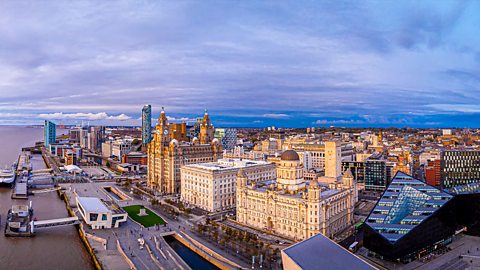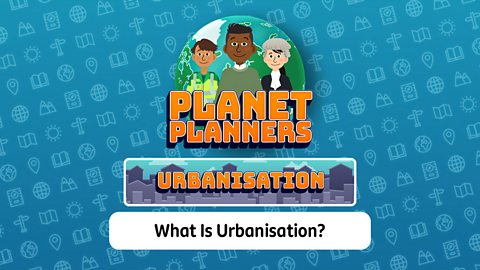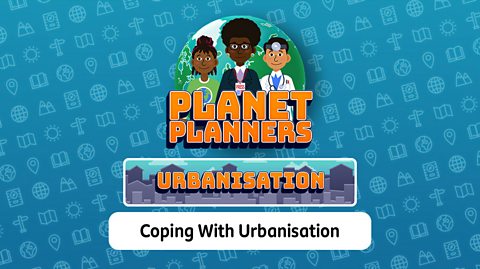What do you know?
What are urban processes?
Urban processes are the changes that cities go through over time. They include urbanisation, counter-urbanisation, suburbanisation and reurbanisation.
Key Points
- Towards the end of the 20th century, many people in high income countries (HICs)Countries recognised by the World Bank as being wealthier. This classification is reviewed yearly. moved away from city centres.
- Some HIC cities are now experiencing reurbanisationWhen areas of a city are repopulated.. This has led to the redevelopmentWhen something is changed to make it better or more up-to-date, eg a disused factory may be redeveloped into new housing. of certain areas of the cities.
- Cities in HICs have many challenges that require careful management. These include congestionTraffic jams. These are often experienced in cities where there are lots of cars on the road., waste disposal, energy use, pollutionSomething in the environment that shouldn’t naturally be there, for example smoke in the air. and access to green spaces.
Game - What is urbanisation?
Play a Planet Planners mission to help people thrive in a rapidly urbanising world.
You can also play the full game
How are cities in HICs changing?
Video: Sustainable transport in cities
Find out about how transport systems in cities are changing
Chloe: Sustainable transport in cities
UPBEAT MUSIC
My name is Chloe and I work for Transport for West Midlands.
My role involves developing sustainable transport links such as train, bus, cycling, and tram routes.
For transport to be sustainable, it has to put people first and provide them with more affordable, accessible, cleaner, and healthier alternatives.
UPBEAT MUSIC
In the UK, the transport sector is responsible for producing a lot of greenhouse gases.
So reducing carbon emissions and improving air quality is really important.
Here in Birmingham, for example, we have introduced more electric vehicle charging points along with cycling and pedestrian routes.
We are extending the tram system to more residents and have introduced a congestion charge to reduce the number of polluting vehicles.
Our plans need to ensure that all sustainable modes of transport link together so people don't have to rely on their cars.
UPBEAT MUSIC
What I love about my job is planning for the future and leaving a cleaner and better-connected transport system for future generations.
MUSIC CONTINUES
Moving away from the city
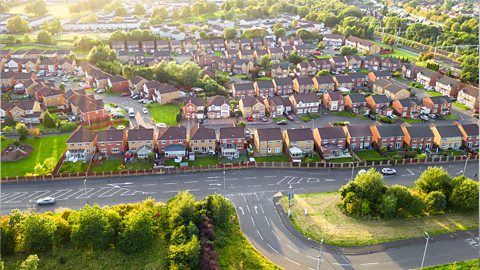
In the late 20th century, many people moved out of certain areas within high income countries (HICs)Countries recognised by the World Bank as being wealthier. This classification is reviewed yearly. cities in search of more space and a better quality of lifeA measure relating to health, wealth and happiness. High quality of life means that someone is healthy, has enough money and feels happy.. This led to an increase in the number of people living in the suburbLand around the edge of a city or town. Suburbs contain lots of land uses, such as housing, shops and offices. or in ruralRelating to the countryside. The opposite of urban. areas.
When people move to the edge of towns or cities, known as the suburbs, this is called suburbanisation. The benefits of the nearby city or town can be enjoyed, without living in its centre. However, some people leave the city completely. This is called counter-urbanisationWhen people leave the city to live in rural areas.. This has become more popular with the ability to work from home, sometimes known as remote working or teleworkingWorking from home due to having the internet, laptops and phones..
The growth of London, for example, is beginning to slow down.

Moving towards the city

Some cities are now experiencing reurbanisationWhen areas of a city are repopulated. as people are drawn back to living in the city. Many areas that were derelictPlaces that are abandoned and in a poor condition, eg an old factory that has been left to ruin., such as factories, have now undergone redevelopment and gentrifiedWhen wealthier residents move into a city area and have the money to improve the housing and attract new businesses.. Cleaner air, better transport systems and more opportunities for entertainmentActivities put in place for the amusement or enjoyment of others, eg cinemas and music events and theatre productions. and recreationActivities done for enjoyment when people are not working or at school or college, eg sports. have attracted a new, younger population to settle in these areas. HIC cities can now offer a better quality of life than before.
Manchester, for example, has recently seen an increase in people living in the city centre.

Question
Why are many people beginning to move back into cities?
Many cities have cleaner air, better transport systems and more opportunities for recreation and entertainment than before. For some people, this can make cities seem like more attractive places to live than the countryside.
Game - Coping with urbanisation
Play a Planet Planners mission to help people deal with the issues that urbanisation brings.
You can also play the full game
How are the challenges of HIC cities overcome?
HIC cities have many challengeThings that are difficult to manage, for example traffic in cities. that require careful management. These include:
Waste disposal
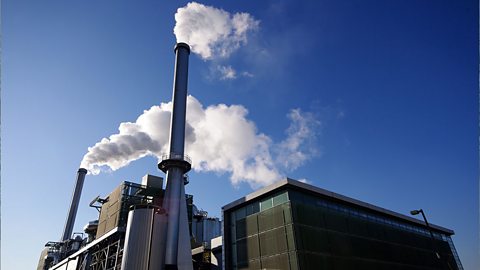
recycling centresPlaces where people can take rubbish to be recycled. decrease landfillThe process of burying rubbish underneath the ground. Much of the UK’s waste is put into landfill, where it may take a very long time to break down.. Some cities operate Energy Recovery Facilities (ERF)Places where rubbish is burnt in order to generate electricity. which incinerateTo burn something, eg burning rubbish. waste to produce electricity.
Congestion
sustainable transportTransport that is environmentally greener and more efficient. systems encourage public transportA way of moving people without the need for private cars, eg trams, buses and trains. use. Examples include integratedWhen things are interlinked and work well together. An integrated transport system may have a network of buses, trains and trams that link the whole city. bus, tram and train networkA series of interconnected things, eg a road network., cycle laneSpecial routes that can only be used by people on bikes. and congestion chargesPayments that have to be made by cars entering certain areas, eg the London congestion charge means that drivers must pay to enter the centre of London..
Pollution
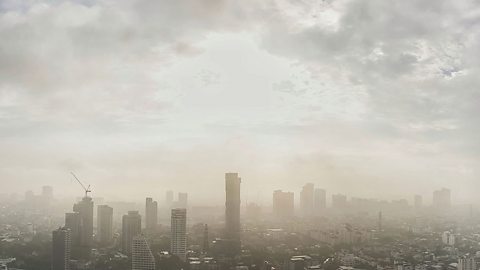
Many cities have introduced laws to improve air quality. Advances in vehicle technology and incentiveSomething that aims to encourage someone to act in a particular way. For example, a government pays money to people in exchange for sending their children to school, or offers lower tax for cars that don't cause pollution to encourage people to use electric vehicles. for using cleaner transport, such as electric vehicleMethods of transport that run off a rechargeable battery rather than traditional fuels, such as petrol or diesel. , have reduced air pollution.
Energy use
New technology has led to energy efficientWhen something uses fewer resources, eg an energy efficient building may take less fuel to heat. buildings. Measures such as improved insulationA layer put around a building or in a roof space to retain heat during colder weather or to keep a building cool during warmer weather. and the use of solar panelA panel designed to convert the heat from the sun to heat water or generate electricity. have decreased energy demand in cities.
Access to green spaces
urban greeningA process to increase the amount of green space within a town or city. brings social, economic and environmental benefits. Access to green spaces can also improve mental healthA person’s emotional well-being..
Game - Environmental consequences
Play a Planet Planners mission to help develop cities while taking care of the environment.
You can also play the full game
Quiz: Challenges in HICs
Urban Greening

- urban greeningA process to increase the amount of green space within a town or city. has increased the amount of green space in cities. Examples include green roofAdapting the roofs of buildings so that they can grow plants on them which can improve air quality and biodiversity., tree-planting schemes, parks and other open spaces.

- Green leaves absorb less heat than building materials. During the summer months, the air around green space is cooler than the air around buildings.

- Roots of plants take up some of the rainwater that would have run into drains. This means that green spaces reduce floodAn overflow of water onto surrounding land after heavy rainfall. risk.

- Plants provide habitats for lots of different insects. Green spaces are good for biodiversityThe range of plants and animals in the world or in a particular area. High biodiversity is considered a good thing. .
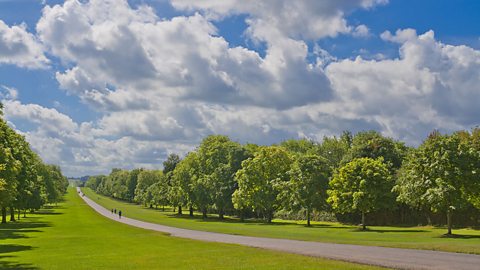
- open spaceAreas that are not covered in buildings, such as parks. provide areas for social interactions, recreationActivities done for enjoyment when people are not working or at school or college, eg sports. and tourismWhere people visit an area for a holiday and spend time away from home. Tourists travel for lots of reasons including recreation, relaxation, and sight-seeing.. They are good for physical and mental health and the local economyAssociated with money. A country or city’s economy refers to the amount of money that the country or city can make..
Question
What are some of the advantages of living in a city?
Cities have good transport networks. This means you can move around easily. They also have lots of shops and entertainment. There are many different jobs in cities, allowing people to earn money.
Quiz: How are cities in HICs changing?
Play the Planet Planners game! gamePlay the Planet Planners game!
Make decisions for the planet in this KS3 geography game.

More on Urbanisation
Find out more by working through a topic
- count3 of 4

- count4 of 4
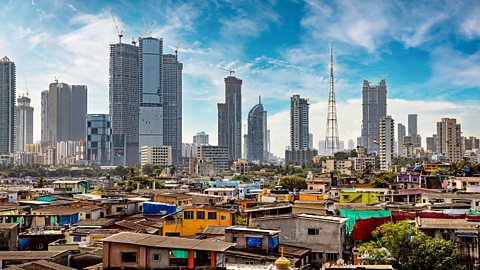
- count1 of 4
